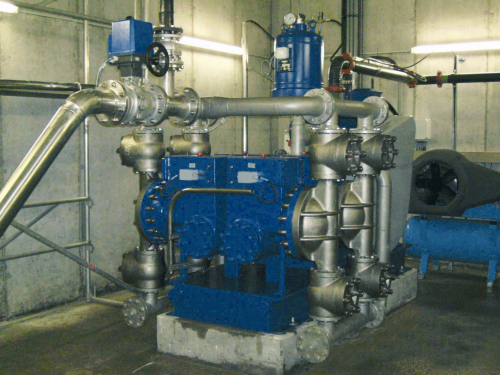
Salinen Austria AG is a European salt supplier. Among its major sales products include brine for the chemical industry, food, industrial and melting salt, and chemically pure salt for pharmaceuticals. The company's three sites at Bad Ischl, Hallstatt, and Altaussee produce more than three million m3 of brine, making Austria is one of the most important salt producers in Europe.
Currently, the Altaussee mine is the largest producing salt mine in Austria, and it is one of the most fully automated subsurface raw material producers in the world. Almost 50% of Austria's salt production originates in the salt deposit of Sandling (1,717 m mountain near Altaussee in the Styrian ‘Salzkammergut’. Using targeted leaching of the salt-rich ‘Haselgebirge’, they extract concentrated brine, chiefly from borehole caverns.
Salinen Austria AG contracted with Altmayer Anlagentechnik Gmbh & Co. KG to construct a system that would be used to transfer tailing piles (leftover materials) from the brine purification process used in the production of evaporated salt into the caverns.
The tailing piles from the brine purification process are used to pack the salt cavities that have been created. The method, while highly ecologically conscious in the sense of closed loop waste management, also packs excavated caverns, increasing the stability of the underground works. The packing material is delivered by lorries from the Ebensee salt works at a dry weight of approx. 70% and unloaded into the two hoppers (figure 2). Using walking floors and screw conveyors, which are found on the floor of both hoppers, the packing material is conveyed into a mixing container (capacity approx. 84 m3). Using an agitator, it is then mixed with the brine removed from the mine to form a homogenous solution with approx. 30% dry matter.
The ABEL pump removes the packing material from the hopper at an internal design pressure of 40 bar and a capacity of 6 to 45 m3/h into the mine via a pipeline that is about 2.5 km long. The mined caverns are then refilled with the packing material. Once the suspension has had time to settle in the caverns, the brine is pumped back up to the surface and is again used for mixing.
Salinen Austria AG planned to use a hydraulically driven double piston pump, known as a ‘thick matter pump’ or ‘solids handling pump’, for transporting the packing material. However, because ABEL has this type of pump as well as piston membrane pumps in its product line, it was possible to convince the customer that a piston membrane pump was technically the better solution for this application. In contrast to solids handling pumps, which are primarily used for highly viscous, almost compacted media, the HMQ, as a piston membrane pump, is ideally suited for abrasive, liquid media.
For this reason, the HMQ was clearly the better choice for conveying the packing material in this application. Because of the type of medium used in this case, ABEL equipped the HMQ-E-100-0500-ED for Salinen Austria with some custom features.
Due to the high salt content of the packing material, the suction and pressure lines, as well as the cone valve housing and pump housing, are made of stainless steel, so that the pump parts that come into contact with the product do not corrode.
The integrated reversing valves are suited for use with the pumped medium and the process pressure. The reversing valves are installed in such a way that the medium's direction of flow through the pump is ‘reversed’. The normal direction of flow for piston membrane pumps is from bottom to top; in this case, the medium now flows from top to bottom. The advantage gained through reversing valves is that the medium is pumped in the same direction of flow in which sedimentation may take place. This means that larger particles cannot lodge in the product valves and the membrane housings, and possible damage to the membrane can be avoided.
The unique feature of the HMQ is the use of ‘iMPD’, the intelligent ABEL membrane pulsation damper. Pulsation dampers minimise pulsations in the system's pipelines. Conventional membrane pulsation dampers must be set (pre-stressed) to a specific pressure range. Each time the operating pressure is changed, such as when the volumetric flow is changed, the pulsation damper's pre-stress must be changed. However, the iMPD automatically adapts to changing operating pressures, providing low residual pulsation over the entire pressure range. The iMPD automatically adapts to the actual operating conditions through the use of a piston compressor.
ABEL iMPDs adjust the charging pressure in the damper to different or changing operating pressures, thus providing quieter operation and a steady volumetric flow.




